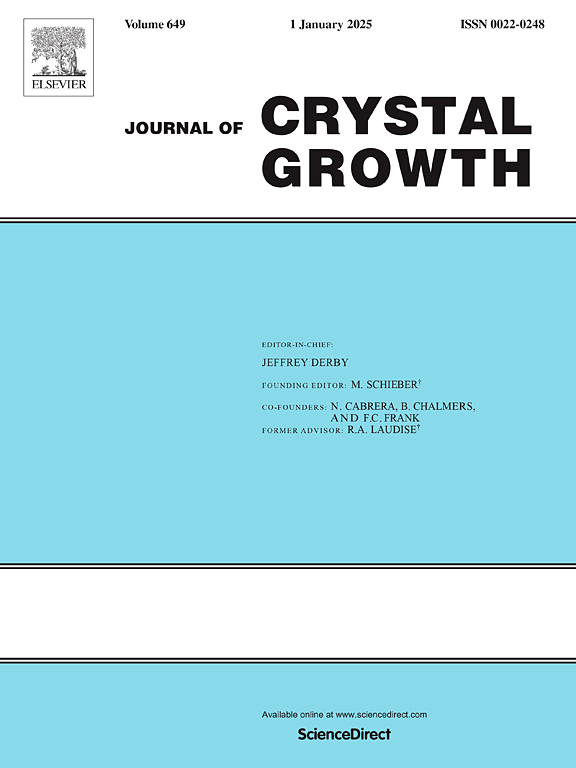微波电场位移对微波等离子体化学气相沉积中金刚石沉积影响的三维模拟研究
IF 1.7
4区 材料科学
Q3 CRYSTALLOGRAPHY
引用次数: 0
摘要
均匀沉积大面积、高质量金刚石厚膜的研究一直是相关研究的突出热点。本文采用有限元法对微波等离子体化学气相沉积(MPCVD)反应器进行了三维模拟,并在COMSOL软件中建立了与实际反应器尺寸相复制的三维模型。通过分析谐振腔内的三维微波电场分布以及与端口反射相关的S11 dB参数,研究了谐振腔非谐波性对大面积金刚石微波等离子体沉积的影响。环形锥天线在谐振腔顶部的偏转和不对中改变了其固有频率,破坏了微波与谐振腔之间的最佳谐振。因此,波导从轴对称传输模式转变为非轴对称传输模式,导致微波电场分布在腔内衬底支架的影响下发生变化。基于金刚石膜沉积过程的实际反馈,对谐振腔顶部结构进行精确优化,可以显著降低微波电场分布的不规则性。这样可以更好地将最大场强集中在预定的中心位置,并最大限度地减少非谐波的影响。该研究为进一步提高MPCVD系统中大面积金刚石厚膜的均匀沉积提供了理论支持。本文章由计算机程序翻译,如有差异,请以英文原文为准。
Effect of microwave electric field displacement on diamond deposition in microwave plasma chemical vapour deposition: a three-dimensional simulation study
The investigation of the uniform deposition of large-area, high-quality diamond thick films has been a prominent focus of related research. Herein, a three-dimensional simulation of the microwave plasma chemical vapour deposition (MPCVD) reactor was conducted using the finite element method, with a three-dimensional (3D) model replicating the actual reactor dimensions built in COMSOL software. By analysing the 3D microwave electric field distribution within the resonant cavity, along with the S11 dB parameter related to port reflection, the influence of resonant cavity anharmonicity on microwave plasma deposition of large-area diamond was examined. The deflection and misalignment of the annular cone antenna at the top of the resonant cavity alter its intrinsic frequency, disrupting the optimal resonance between the microwave and the cavity. Consequently, the waveguide transitions from an axially symmetric transmission mode to a non-axially symmetric one, resulting in variations in the microwave electric field distribution under the influence of the substrate holder within the cavity. Based on actual feedback from the diamond film deposition process, precise optimisation of the resonant cavity’s top structure can significantly reduce irregularities in the microwave electric field distribution. This allows for better concentration of maximum field strength at the intended central position and minimises the effects of anharmonicity. This study offers theoretical support for further enhancing the uniform deposition of large-area diamond thick films in MPCVD systems.
求助全文
通过发布文献求助,成功后即可免费获取论文全文。
去求助
来源期刊

Journal of Crystal Growth
化学-晶体学
CiteScore
3.60
自引率
11.10%
发文量
373
审稿时长
65 days
期刊介绍:
The journal offers a common reference and publication source for workers engaged in research on the experimental and theoretical aspects of crystal growth and its applications, e.g. in devices. Experimental and theoretical contributions are published in the following fields: theory of nucleation and growth, molecular kinetics and transport phenomena, crystallization in viscous media such as polymers and glasses; crystal growth of metals, minerals, semiconductors, superconductors, magnetics, inorganic, organic and biological substances in bulk or as thin films; molecular beam epitaxy, chemical vapor deposition, growth of III-V and II-VI and other semiconductors; characterization of single crystals by physical and chemical methods; apparatus, instrumentation and techniques for crystal growth, and purification methods; multilayer heterostructures and their characterisation with an emphasis on crystal growth and epitaxial aspects of electronic materials. A special feature of the journal is the periodic inclusion of proceedings of symposia and conferences on relevant aspects of crystal growth.
 求助内容:
求助内容: 应助结果提醒方式:
应助结果提醒方式:


